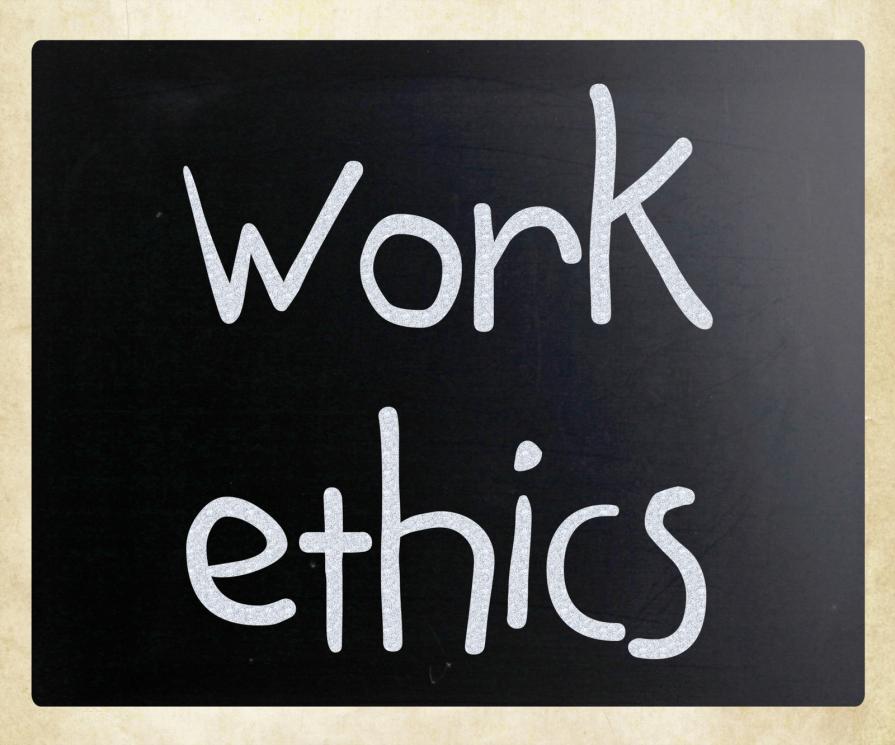corporate leadership
How To Improve Your Professional Ethics
Careless or professional, a person’s work ethics can make or break his/her reputation at work and career growth. Increase your professional ethics by evaluating your current attitudes towards work, identify your pitfalls and take help from these five easy tips to have stronger work ethics and a fulfilling professional life.
Be dedicated and punctual
Strong work ethics are reflected by an employee’s dedication and commitment to his job. Maintain a regular attendance, take responsibility and ownership for your performance, remain focused on your targets, and put in extra efforts to complete your assignments to the best of your ability. You may need to occasionally dedicate a few extra hours, but take it as your chance to outshine the rest of employees.
Your punctuality at work speaks volumes about your professional ethics. Make sure you are on time to work and all work-related appointments. Submit your work in time, foresee delays, and let your employer know about your absences in advance.
Be reliable
Make sure to fulfill all promises and honor your project deadlines; in case you anticipate a delay, take your manager into confidence and set another realistic deadline. Being dependable is the backbone of maintaining an ethical reputation, and induces a relationship of trust between the employer and employees as well as between coworkers by showing that you prove what you portray.
Aim high in productivity and quality of work
Sometimes just working to keep your job intact is not enough. Those with good work ethics remain vigilant about their quality of work. Avoid being a passenger in your team and become a productive member instead. Your quality of work ultimately integrates into the company’s overall quality and reputation.
Finish your assigned tasks before the shift ends and strive to earn a better project next time. Be competitive yet attentive to instructions and details. Don’t hesitate to get help, even when you are leading. Set a standard of quality for you to achieve and take initiative to get projects started instead of waiting to be asked. Your positivity, problem-solving skills, flexibility, communication skills, and openness to feedback will always come in handy to earn you a good reputation at work.
Be cooperative to your co-workers and respectful of your work resources
Respect your peers, be willing to help them and avoid getting interfering or too personal in your interactions. Maintain healthy professional relationships with your coworkers to make collaborations and teamwork go smoother. Be an important contributor to your team and help them meet collective objectives.
To increase your professional ethics, it is absolutely vital that you remain respectful of your work time and resources. Respect the company’s privacy and data protection policies; use office time to work instead of personal engagements, save lunch breaks for personal chats with colleagues and treat all equipment and supplies with care. Your appearance reflects your work ethics, so make sure to dress professionally and maintain a moderate attitude.
Demonstrate a strong character
A good work ethic and a strong character are synonymous to each other in a workplace. Stay modest about your achievements and honest about your setbacks, and foster a trusting bond with clients, managers and colleagues by offering them honest feedback and advice. Your high moral standards, self discipline, and self-motivation will distinguish for the rest of the workforce and convince your supervisors of your loyalty to the company and non-problematic nature.
What Makes a Great Leader?
When you feel that resources are tight, stress levels are running high, your visions of success are blurring out and nothing seems to go according to your plan, you may find yourself easily giving up as a leader and watching your team sink. Take a deep breath, calm down, remind yourself of your leadership aspirations, and re-emphasize on these key qualities that make a great leader:
Honest and Committed
A true leader makes an exceptional leader, period. If you think a certain leader is great because he hid their latest loss from her team, or lied to them about why they underperformed on a certain task, you may want to reconsider. A leader’s team is a reflection of her own morals, so she needs to demonstrate an honest and ethical behavior to expect her team to follow suit. By implementing these values, an exceptional leader commits to ensure that all her teammates are on the same page of standards, and induces a professional and healthy environment to work in.
Farsighted and Expressive
The bleak difference between a good and a great leader is her farsightedness and self-expression. Setting a clear vision of future strategies and performance, and effectively communicating it to the team provides them with a sense of direction and effectively provides employees with an understanding of their roles, responsibilities and conduct. A great leader always stays a step ahead of time and tends to forecast her team’s future success and pitfalls in order to prepare and act accordingly, while taking her team into confidence and keeping them updated with any future plans and strategic changes.
Inspirational and Motivating
Ever been in a situation where you lost all hopes of being successful and needed someone to look up to for inspiration? A great leader does just that! Like a captain goes all out to rescue his sinking ship, a true leader stays composed through adverse situations to keep the team spirits high and boost their morale. Reminding the team members of their achievements uplifts their self-motivation and encourages them to aim higher and perform at a next level.
Confident and Demonstrates a Positive Attitude
There may be nothing worse than being led by a pessimist. A leader has to display a positive attitude in order to steer her team into the right direction. Keep your confidence level high, and reassure everyone that hindrances are normal, and to maintain their focus on the ultimate goal. A calm and confident leader keeps her team from feeling overwhelmed under pressure. Observe a certain level of damage control, reinforce the positivity into your team, and become an exceptional leader by keeping everyone working and moving forward.
Creative and Humorous
While these two qualities may rank last on the list, they are equally essential to have to be an inspirational leader. While a leader’s creative flair can make or break her team, humor makes her see the lighter side of things during a crisis and as your team takes the cue from you, it will keep their moods uplifted and expectations high. As a leader, many of your decisions may not be clear-cut and might force you to be flexible around your set course of action and step out of your comfort zone. Creativity becomes vital in such situations and enables a leader to think outside the box and weigh her choices before arriving at a final decision.
Leadership Game | Back To Back Drawing Student Leadership Game
Leadership Game | Back To Back Drawing Student Leadership Game
© Russ Peak | Leadership Has Never Been This Fun! | Leadership-Ideas.com
[divider height=”30″ line=”1″]
Description
In this student leadership game, your students will learn the importance of clear communication as they pair up back-to-back and attempt to re-create a drawing with only limited verbal instructions.
Purpose
This activity teaches effective communications skills. It emphasizes the importance of giving clear instructions when presenting your ideas. Whether giving instructions to a teammate, presenting your student council election speech, or advertising the next school dance… the presence of clear and specific directions will ensure the success of your student leadership efforts.
Group Size
Any
Materials Required
A Pad of paper and pencil for each pair of players
Shape drawings (Download & Print this PDF with Shapes)
Optional – Use a dry erase board for writing participant’s key point answers and “a-ha!” moments during discussion.
Time Required
15-30 minutes
[divider height=”30″ line=”1″]
INSTRUCTIONS
Get Ready & Explanation
- Divide your group into pairs.
- Instruct each pair to sit on the floor back to back.
- Give one person in each pair a pencil and pad of paper.
- Explain that the player holding the picture will give verbal instructions to their partner on how to draw the shape – without actually telling the partner what the shape is.
- Show your group the drawing of the square and explain:
“You may not simply say, ‘Draw a square!’ Or even ‘Draw the shape of SpongeBob’s body.’”
“Instead, you will give step-by-step directions.”
“For example: If this were describing the SQUARE, I’d say…”
“Draw a line horizontally across the page.”
“At the end of the line you just drew, draw a line going down the page… Etc.”
Note: Don’t complete the whole drawing or get too specific in your drawing example. Let them figure that out themselves. Discard the square.
Play The Game
- Pass out a shape to the paired player who does not have the pencil and pad of paper. Make sure to only let the direction giving player see the shape.
- “Go! Artists… no looking!”
- When the drawing is complete. Ask each pair to compare their original shape with the actual drawing.
- Play this game 3 or 4 times allowing the pairs to see the outcome of their drawings. Pass out a different shape each game and allow pairs to switch who is the communicator and who is the drawer.
[divider height=”30″ line=”1″]
DISCUSSION IDEAS
 During the first round, how well did the direction giver describe the shape? How well did the second person interpret the instructions?
During the first round, how well did the direction giver describe the shape? How well did the second person interpret the instructions?- Were there problems with both the sending and receiving parts of the communication process?
- What did you do to improve the communication process? What was the result?
- Have you experienced a situation where bad communication was an issue? What happened? How could have more direct communication have helped?
- What can we learn from this in our attempts to reach out to our campus and community as leaders?
- Is there anything we are currently doing as student leadership that could be improved with better communication efforts?
[divider height=”30″ line=”1″]
COMMENTS
- Use basic shapes for the first couple of rounds. Switch in the more difficult shapes as your student leaders catch on.
- Remember, like many team-building and student leadership games, this in not just a quick game in route to an object lesson. This game actually is great practice in developing these invaluable student leadership skills. Incorporate this and other leadership skill building games into your leadership or student council class on a weekly basis.
- Ideas stick better when accompanied by a personal example. Your student leaders will gain greater retention of your discussion points when they accompany their basic answers with an example or descriptive story, hypothetical or real, that involves how they have or will use their leadership skills in a personal away. Encourage this sort of response and ask follow up questions.
- New at leading group games? Check out this article that explains the simple secrets that will leave you leading games like a pro! Playing With A Purpose: Simple Secrets To Student Leadership Games That Teach And Inspire
• • • •




